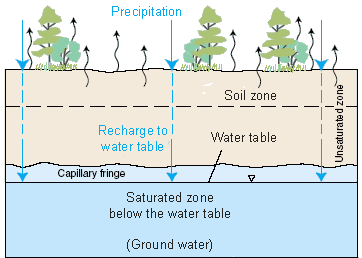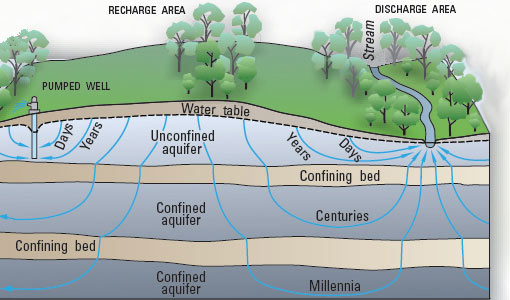The following blog post is a summary of material found in Chapter 3, Water and Hydrogeology of Watersheds from the text by Kaufman, M., Rogers, D., and Murry, Kent. 2011. Urban Watersheds; Geology, Contamination, and Sustainable Development. Taylor and Francis Group, LLC. Boca Raton, FL.
Clean water is essential to maintain health of all species
on earth. Water and geology help to shape our natural environment. We are
learning more and more about how human impacts in the natural and built
environmental are impacting our ground and surface waters.
Groundwater in
Watersheds
Groundwater is defined as “any water beneath the surface of
the ground”. Apart from the bound water in icecaps and glaciers, over 95% of
all freshwater sources on Earth come from groundwater. Imagine poring all the
earth’s groundwater out onto the US land surfaces, it would spread to a depth of
a half-mile. On a global scale, if water covered all land surfaces, the water
would be 150’ deep. The total amount of groundwater on Earth is 100 times more
than all the visible surface water in lakes, streams, rivers, and swamps.
Much of the groundwater of the US is found in aquifers. An
aquifer is considered a “mappable geologic
unit” that is created by water-saturated porous media, usually sands and gravels,
which have the capacity to store and move large amounts water. Finer grained
materials like clay and silt may not transmit water quickly enough to be
considered as an aquifer media. Up to 50% of the US population obtains its
drinking water from groundwater sources. In addition, agriculture uses groundwater at about 40% for irrigation of crops.
Groundwater is in constant motion under the force of gravity
and moves from higher to lower areas of pressure. Movement occurs through a system
of passageways of unsaturated pore spaces in soils and sediment. This zone of
aeration is known as the vadose
zone.
Pressure is naturally higher under mountains and hills due to mass and valleys are under lower pressure; resulting in a pressure gradient where groundwater flows to the surface and can interact with surface water.
 |
| Sourced: http://water.usgs.gov/edu/graphics/wcinfiltrationsoilzone.gif |
Pressure is naturally higher under mountains and hills due to mass and valleys are under lower pressure; resulting in a pressure gradient where groundwater flows to the surface and can interact with surface water.
 |
| Sourced: http://water.usgs.gov/edu/graphics/wcgwdischarge.jpg |
Groundwater and
Surface Waters
 |
| Sourced: http://water.usgs.gov/edu/watercyclesummary.html |
Groundwater and surface waters are interconnected in watersheds. Climate, vegetation, topography, rainfall, and geology all influence patterns of surface water flow and drainage density.
Ground water provides an important influx of water to
surface waters that serves to protect aquatic life through periods of low
precipitation and drought. Streams, lakes and wetlands can gain groundwater;
conversely surface waters can flow into groundwater. Soils with low
conductivity in the vadose zone can impair ground and surface water
communication. Additionally, a lowering of the water table due to drought,
local geology, or excessive groundwater use can impair connectivity.
Important research must be done on ground and surface water
connectivity within urban areas. Toxins and pollutants, like those found in the
first flush of stormwater runoff can contaminate groundwater that is close to
the surface. Groundwater contamination also has the ability to reach surface
waters. Additionally, removal of large groundwater quantities near a surface
water body can cause some loss of the surface waters; impairing aquatic
functions.
Urban area watershed influences are numerous and can
include: runoff from impervious surfaces creates increased erosion and
sedimentation, petroleum-based contaminants from vehicles, groundwater
contamination from industry, wetland destruction, wastewater discharge,
combined sewer overflows (CSOs), aging infrastructure, stream bed alterations,
other point and non-point pollution sources, dam construction altering
groundwater levels, and natural drainage system alterations.
No comments:
Post a Comment